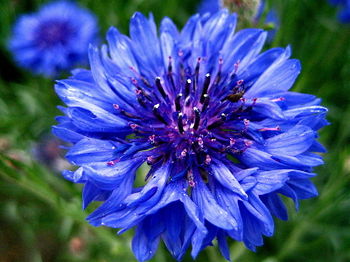Cornflower
From Wikiwel
Other Names : Centaurea cyanus, Bachelor’s button, blueblow, blue cap, blue poppy, bluebonnets, bluebottle, hurtsickle, kornblomst, Kornblume, blåklint, Kornblom, kornblóm, azulejo, bleuet, casse lunette, ruiskaunokki.
It is primarily the dried flower heads that have been used medicinally. The leaves and seeds have also been used to some extent in herbal medicine.
Special Precautions of Cornflower
- Those with a known allergic sensitivity to ragweed, daisies, dandelions or sunflowers will need to avoid cornflowers, due to the possibility of a similar allergic reaction.
- Those who are pregnant or nursing should consult a physician before ingesting any tinctures or infusions.
- As cornflowers have an anti-inflammatory characteristic, their use in conjunction with other anti-inflammatory drugs should be carefully monitored.
- Those who are being treated for urinary tract stones should also avoid large quantities of infusions of the flower heads, as its diuretic properties will act in addition to the treatment already applied by other medications
The benefits of Cornflower are
Because it contains active substances like tannin and potassium salts, cornflower has astringent, weak diuretic, bitter-tonic anti-inflammatory and soothing proprieties.
- Taken internally as an herbal tea, it is thought to aid in soothing stomach ulcers,
- Rinsing with the tea is regarded to speed the healing of sores or bleeding gums in the mouth.
- Recommended in treating diarrhea
- Stronger infusions of the flower buds have been used to treat urinary tract infections, as the properties of the plant include antibiotic and antiseptic qualities.
- also recommended for alleviating rheumatism and anorexia.
- The tea can also be good for improving digestion, and the herb’s high antioxidant content aids in detoxifying the liver.
- Taken internally as a tea, the flowers can also impart their antibiotic and antioxidant properties as a preventative for warding off illnesses like the common cold.
- An infusion of the seeds has been used historically in Europe for treating constipation. A gentle infusion of the petals is also said to treat yeast infections in women when applied internally.
- Cornflowers are also said to stimulate the appetite when taken as a tea.
- Externally, cornflower has various applications. It has soothing and antiseptic effects and is used under the form of poultices in cases of conjunctivitis, irritations and inflammations of eye lids.
- Due to its soothing effects, cornflower is used in treating facial muscles and wrinkles. It is also used in treating afflictions like eczemas and ulcerations.
- Wounds : The natural tannin found in the plant helps to bind proteins, which makes its use as a wound treatment particularly effective. It can assist in stopping bleeding in open wounds and bleeding gums.
- In popular medicine, cornflower is used as infusion to threat the dark rings bellow the eyes. The active substances contained in cornflower deter the formation of the rings below the eyes, and at the same time smoothes the skin around the eyes.
- Locally, cornflower detoxifies the body.
- The plant also has a beneficial effect when the flower heads and crushed leaves are applied as a poultice to bruises, aching muscles, and inflamed joints, due to its anti-inflammatory qualities.
- A highly concentrated infusion of the flower heads, either fresh or dried, can be used as a wash on the scalp to get rid of dandruff. Furthermore, the herb can be used to sooth eczema flare-ups.
